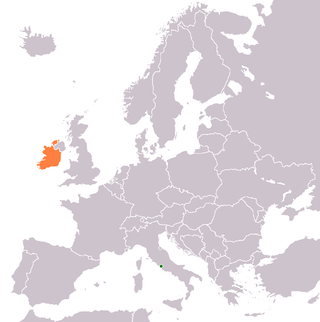
An apostolic nuncio is an ecclesiastical diplomat, serving as an envoy or a permanent diplomatic representative of the Holy See to a state or to an international organization. A nuncio is appointed by and represents the Holy See, and is the head of the diplomatic mission, called an apostolic nunciature, which is the equivalent of an embassy. The Holy See is legally distinct from the Vatican City or the Catholic Church. In modern times, a nuncio is usually an archbishop.

The Apostolic Nunciature to the United States, sometimes referred to as the Vatican Embassy, is the diplomatic mission of the Holy See to the United States. It is located at 3339 Massachusetts Avenue, Northwest, Washington, D.C., in the Embassy Row neighborhood. Since 2016, the papal nuncio has been Archbishop Christophe Pierre.

The current United States Ambassador to the Holy See is Joe Donnelly, who replaced the ad interim Chargé d'Affaires, Patrick Connell, on April 11, 2021. The Holy See is represented by its apostolic nuncio, Archbishop Christophe Pierre, who assumed office on April 12, 2016. The U.S. Embassy to the Holy See is located in Rome, in the Villa Domiziana. The Nunciature to the United States is located in Washington, D.C., at 3339 Massachusetts Avenue, N.W.

Relations between the Holy See and the Republic of China were established on a non-diplomatic level in 1922 and at a diplomatic level in 1942. The Holy See, under the One-China policy, recognizes the Republic of China as the representative of China.

Holy See–United Kingdom relations are foreign relations between the Holy See and the United Kingdom.
The Holy See has long been recognised as a subject of international law and as an active participant in international relations. One observer has stated that its interaction with the world has, in the period since World War II, been at its highest level ever. It is distinct from the city-state of the Vatican City, over which the Holy See has "full ownership, exclusive dominion, and sovereign authority and jurisdiction".

Although the Roman Catholic Church has been territorially established in Canada since the founding of New France in the early 17th century, Holy See–Canada relations were only officially established during the pontificate of Pope Paul VI in 1969.

The Holy See and the State of Palestine established formal diplomatic relations in 2015, through the mutual signing of the Comprehensive Agreement between the Holy See and the State of Palestine. In 2017, a Palestinian embassy to the Holy See was opened.

Holy See–Ireland relations are foreign relations between the Holy See and Ireland. The majority of Irish people identify as Roman Catholic, according to census data. However, views on actual church dogma both on social and spiritual matters varies significantly, and weekly mass attendance is below 40%. The Holy See has an Apostolic Nunciature in Dublin.

Holy See – Mexico relations are foreign relations between the Holy See and Mexico. Catholicism was introduced in Mexico in 1519 by the Spanish Empire. The majority of Mexicans practice the Catholic faith, however, since the adoption of the current Constitution in 1917, Mexico is a secular nation.

Holy See–Vietnam relations are foreign relations between the Holy See and Vietnam. Diplomatic relations have never been established between the two entities, but Vietnam is the only communist state in Asia to have unofficial and bilateral relations with the Vatican.

Holy See–Malaysia relations are foreign relations between the Holy See and Malaysia.

Holy See and Indonesia established diplomatic relations in 1950. Relations are important as part of global interfaith dialogue, because Indonesia has the world's largest Muslim-majority population. Indonesia recognizes Roman Catholicism as one of its six approved religions. The Holy See has a nunciature in Jakarta, while Indonesia has an embassy in Rome.

Georgia – Holy See relations are bilateral relations between Georgia and the Holy See. The diplomatic relations between the two were established on May 5, 1992. The Georgian Embassy to the Holy See is located in 25 Via Toscana, Rome. The Apostolic Nunciature is located in 40 Zghenti Street, Tbilisi.

Holy See–Philippines relations refers to the relations between the Holy See and the Philippines. As one of two Catholic-majority countries in Asia, the Philippines enjoys significant relations with the Holy See. The Holy See has a nunciature in Manila, and the Philippines has an embassy to the Holy See based in Rome.

Croatia–Holy See relations refer to the bilateral relationship between Croatia and the Holy See. Diplomatic relations among the two countries were established on February 8, 1992, following Croatia's independence from SFR Yugoslavia, although they date far back in history.

Central African Republic–Holy See relations refers to the current and historic relationship between the Central African Republic and the Holy See. Diplomatic relations between the two states were established in 1967, but only in recent years they have been increasing their cooperation, with high level visits being made by Pope Francis and President Faustin-Archange Touadéra to each other's countries.

Bulgaria–Holy See relations were formally established in 1990, shortly after the fall of the Bulgarian communist government. Since then, Bulgaria and the Holy See have had an increase in relations, with Pope John Paul II visiting the country in 2002, and more recently visits from Secretary of State Angelo Sodano (2005) and Pietro Parolin (2016).

Holy See–Myanmar relations refers to bilateral relations between the Holy See, which is sovereign over the Vatican City, and Myanmar, also known as Burma. As of August 2017, Archbishop Paul Tschang In-Nam is the first Apostolic Nuncio to Myanmar, while San Lwin is Myanmar's ambassador to the Holy See.

Brazil–Holy See relations refers to the current and historical relations between Brazil and the Holy See. Catholicism was introduced in Brazil in 1500 by the Portuguese Empire, and it is the country's predominant faith. Brazil also has the world's largest Catholic population. Since the adoption of the Constitution in 1891, Brazil is a secular nation.


























